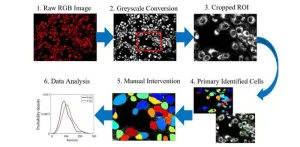(Press-News.org) Generative AI, a technology that is developing at breakneck speed, may carry hidden risks that could erode public trust and democratic values, according to a study led by the University of East Anglia (UEA).
In collaboration with researchers from the Getulio Vargas Foundation (FGV) and Insper, both in Brazil, the research showed that ChatGPT exhibits biases in both text and image outputs — leaning toward left-wing political values — raising questions about fairness and accountability in its design.
The study revealed that ChatGPT often declines to engage with mainstream conservative viewpoints while readily producing left-leaning content. This uneven treatment of ideologies underscores how such systems can distort public discourse and exacerbate societal divides.
Dr Fabio Motoki, a Lecturer in Accounting in UEA’s Norwich Business School, is the lead researcher on the paper, ‘Assessing Political Bias and Value Misalignment in Generative Artificial Intelligence’, published today in the Journal of Economic Behavior and Organization.
Dr Motoki said: “Our findings suggest that generative AI tools are far from neutral. They reflect biases that could shape perceptions and policies in unintended ways.”
As AI becomes an integral part of journalism, education, and policymaking, the study calls for transparency and regulatory safeguards to ensure alignment with societal values and principles of democracy.
Generative AI systems like ChatGPT are re-shaping how information is created, consumed, interpreted, and distributed across various domains. These tools, while innovative, risk amplifying ideological biases and influencing societal values in ways that are not fully understood or regulated.
Co-author Dr Pinho Neto, a Professor in Economics at EPGE Brazilian School of Economics and Finance, highlighted the potential societal ramifications.
Dr Pinho Neto said: “Unchecked biases in generative AI could deepen existing societal divides, eroding trust in institutions and democratic processes.
“The study underscores the need for interdisciplinary collaboration between policymakers, technologists, and academics to design AI systems that are fair, accountable, and aligned with societal norms.”
The research team employed three innovative methods to assess political alignment in ChatGPT, advancing prior techniques to achieve more reliable results. These methods combined text and image analysis, leveraging advanced statistical and machine learning tools.
First, the study used a standardized questionnaire developed by the Pew Research Center to simulate responses from average Americans.
“By comparing ChatGPT’s answers to real survey data, we found systematic deviations toward left-leaning perspectives,” said Dr Motoki. “Furthermore, our approach demonstrated how large sample sizes stabilize AI outputs, providing consistency in the findings.”
In the second phase, ChatGPT was tasked with generating free-text responses across politically sensitive themes.
The study also used RoBERTa, a different large language model, to compare ChatGPT’s text for alignment with left- and right-wing viewpoints. The results revealed that while ChatGPT aligned with left-wing values in most cases, on themes like military supremacy, it occasionally reflected more conservative perspectives.
The final test explored ChatGPT’s image generation capabilities. Themes from the text generation phase were used to prompt AI-generated images, with outputs analysed using GPT-4 Vision and corroborated through Google’s Gemini.
“While image generation mirrored textual biases, we found a troubling trend,” said Victor Rangel, co-author and a Masters’ student in Public Policy at Insper. “For some themes, such as racial-ethnic equality, ChatGPT refused to generate right-leaning perspectives, citing misinformation concerns. Left-leaning images, however, were produced without hesitation.”
To address these refusals, the team employed a ’jailbreaking’ strategy to generate the restricted images.
“The results were revealing,” Mr Rangel said. “There was no apparent disinformation or harmful content, raising questions about the rationale behind these refusals.”
Dr Motoki emphasized the broader significance of this finding, saying: “This contributes to debates around constitutional protections like the US First Amendment and the applicability of fairness doctrines to AI systems.”
The study’s methodological innovations, including its use of multimodal analysis, provide a replicable model for examining bias in generative AI systems. These findings highlight the urgent need for accountability and safeguards in AI design to prevent unintended societal consequences.
The paper, ‘Assessing Political Bias and Value Misalignment in Generative Artificial Intelligence’ by Fabio Motoki, Valdemar Pinho Neto, and Victor Rangel, is published 4 February 2025 in the Journal of Economic Behavior and Organization.
END
Generative AI bias poses risk to democratic values
2025-02-04
ELSE PRESS RELEASES FROM THIS DATE:
Study examines how African farmers are adapting to mountain climate change
2025-02-03
A new international study highlights the severity of climate change impacts across African mountains, how farmers are adapting, and the barriers they face – findings relevant to people living in mountain regions around the world.
"Mountains are the sentinels of climate change,” said Julia Klein, a Colorado State University professor of ecosystem science and sustainability and co-author of the study. “Like the Arctic, some of the first extreme changes we're seeing are happening in mountains, from glaciers melting to extreme events. There's greater warming at higher elevations, so what's happening in mountains is foreshadowing what's going ...
Exposure to air pollution associated with more hospital admissions for lower respiratory infections
2025-02-03
Air pollution is a well-known risk factor for respiratory diseases such as asthma and chronic obstructive pulmonary disease (COPD). However, its contribution to lower respiratory infections —those that affect the lower respiratory tract, including the lungs, bronchi and alveoli— is less well documented, especially in adults. To fill this gap in knowledge, a team from the Barcelona Institute for Global Health (ISGlobal), a centre supported by the ”la Caixa” Foundation, assessed the effect of air pollution ...
Microscopy approach offers new way to study cancer therapeutics at single-cell level
2025-02-03
Understanding how tumors change their metabolism to resist treatments is a growing focus in cancer research. As cancer cells adapt to therapies, their metabolism often shifts, which can help them survive and thrive despite medical interventions. This process, known as metabolic reprogramming, is a key factor in the development of treatment resistance. However, current methods to study these changes can be costly, complex, and often destructive to the cells being studied. Researchers at the University of Kentucky have developed a new, simpler approach to observe these metabolic shifts in cancer cells, offering a more accessible and effective tool for cancer research.
As ...
How flooding soybeans in early reproductive stages impacts yield, seed composition
2025-02-03
FAYETTEVILLE, Ark. — With an increasing frequency and intensity of flooding events and an eye to capitalize on a common rice production technique, soybean breeders are on a quest to develop varieties with flood tolerance at any stage in the plant’s development.
Farmers who use zero-grade fields for rice as their main production system are also interested in flood-tolerant soybean varieties for crop rotation, said Caio Vieira, assistant professor of soybean breeding and a researcher for the Arkansas Agricultural Experiment Station, the University of Arkansas ...
Gene therapy may be “one shot stop” for rare bone disease
2025-02-03
For the last 10 years, the only effective treatment for hypophosphatasia (HPP) has been an enzyme replacement therapy that must be delivered by injection three-to-six times each week.
“It's been a tremendous success and has proven to be a lifesaving treatment,” said José Luis Millán, PhD, professor in the Human Genetics Program at Sanford Burnham Prebys. “Many children who have been treated otherwise would have died shortly after birth, and they are now able to look forward to long lives.
“It is, however, a very invasive treatment. Some patients have reactions from frequent injections and discontinue ...
Protection for small-scale producers and the environment?
2025-02-03
Sustainability certificates such as Fairtrade, Rainforest Alliance and Cocoa Life promise to improve the livelihoods of small-scale cocoa producers while preserving the biodiversity on their plantations. Together with the European Commission's Joint Research Centre, researchers from the University of Göttingen have investigated whether sustainability certificates actually achieve both these goals. To find out, they carried out an analysis within the Ghanaian cocoa production sector. Their results show that although certification improves both cocoa yield and cocoa income for small-scale producers, they were unable to ...
Researchers solve a fluid mechanics mystery
2025-02-03
What began as a demonstration of the complexity of fluid systems became an art piece in the American Physical Society’s Gallery of Fluid Motion, and ultimately its own puzzle that the researchers just solved. Their new study is published in the journal Physical Review Letters.
“We came up with this experiment because we were having a hard time convincing people of certain effects happening for the problem of drag reduction,” said assistant
professor Paolo Luzzatto-Fegiz, an assistant professor of mechanical engineering, whose research specialties include modeling flow and investigating drag — as ...
New grant funds first-of-its-kind gene therapy to treat aggressive brain cancer
2025-02-03
The California Institute for Regenerative Medicine has awarded a $6 million grant to USC investigators pioneering a new first-of-its-kind genetic therapy for glioblastoma, a severe form of brain cancer. The treatment would be the first gene therapy for glioblastoma to use a novel, more precise delivery system that is less likely to harm non-cancerous cells.
Glioblastoma is an aggressive and fast-growing cancer originating in the brain that occurs primarily in adults and has no known cure. Patients diagnosed with this type of tumor have a five-year survival rate of just 5 percent. The cancer’s location—in the sensitive brain—combined ...
HHS external communications pause prevents critical updates on current public health threats
2025-02-03
The Society for Healthcare Epidemiology of America (SHEA) is concerned that two weeks have passed since the Department of Health and Human Services (HHS) announced a pause on mass communications and public appearances that are not directly related to emergencies or critical to preserving health. With the order remaining in effect until a new HHS secretary is confirmed, this unpredictable timeline prolongs uncertainty for both healthcare professionals and the public, and endangers the nation by hindering our ability to detect and respond to public health threats, such as avian influenza (H5N1). Public ...
New ACP guideline on migraine prevention shows no clinically important advantages for newer, expensive medications
2025-02-03
Embargoed for release until 5:00 p.m. ET on Monday 3 February 2025
@Annalsofim
Below please find summaries of new articles that will be published in the next issue of Annals of Internal Medicine. The summaries are not intended to substitute for the full articles as a source of information. This information is under strict embargo and by taking it into possession, media representatives are committing to the terms of the embargo not only on their own behalf, but also on behalf of the organization they represent.
----------------------------
New ...




